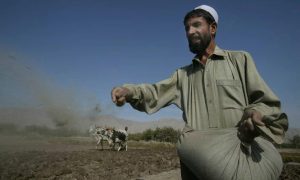Heroin trade in Helmand; U.S and Britain failed in Afghanistan

After 16 years and $1tn spent, there is no end to the fighting – but western intervention has resulted in Afghanistan becoming the world’s first true narco-state.
According to the latest report of the Guardian, after fighting the longest war in its history, the US stands at the brink of defeat in Afghanistan. How could this be possible? How could the world’s sole superpower have battled continuously for more than 16 years – deploying more than 100,000 troops at the conflict’s peak, sacrificing the lives of nearly 2,300 soldiers, spending more than $1tn (£740bn) on its military operations, lavishing a record $100bn more on “nation-building”, helping fund and train an army of 350,000 Afghan allies – and still not be able to pacify one of the world’s most impoverished nations? So dismal is the prospect of stability in Afghanistan that, in 2016, the Obama White House cancelled a planned withdrawal of its forces, ordering more than 8,000 troops to remain in the country indefinitely.
The report says, in the American failure lies a paradox: Washington’s massive military juggernaut has been stopped in its steel tracks by a small pink flower – the opium poppy. Despite almost continuous combat since the invasion of October 2001, pacification efforts have failed to curtail the Taliban insurgency.
The Guardian wrote: at each stage in its tragic, tumultuous history over the past 40 years – the covert war of the 1980s, the civil war of the 90s and its post-2001 occupation – opium has played a central role in shaping the country’s destiny.
It further continued: the CIA looked the other way while Afghanistan’s opium production grew from about 100 tonnes annually in the 1970s to 2,000 tonnes by 1991. In 1979 and 1980, just as the CIA effort was beginning to ramp up, a network of heroin laboratories opened along the Afghan-Pakistan frontier.That region soon became the world’s largest heroin producer. By 1984, it supplied a staggering 60% of the US market and 80% of the European.
According to the report, over the longer term, the US intervention produced a black hole of geopolitical instability that would never again be sealed or healed. Afghanistan could not readily recover from the unprecedented devastation it suffered in the years of the first American intervention.
The newspaper wrote: in September 2000, the Taliban sent a delegation to UN headquarters in New York to trade upon the country’s continuing drug prohibition in a bid for diplomatic recognition. Instead, the UN imposed new sanctions on the regime for protecting Osama bin Laden. The US, on the other hand, actually rewarded the Taliban with $43m in humanitarian aid, even as it seconded UN criticism over Bin Laden. Announcing this aid in May 2001, secretary of state Colin Powell praised “the ban on poppy cultivation, a decision by the Taliban that we welcome”, but still urged the regime to end “their support for terrorism.
According to a 2007 New York Times report, defense secretary Donald Rumsfeld reportedly “dismissed growing signs that drug money was being funnelled to the Taliban”, while the CIA and the military “turned a blind eye to drug-related activities by prominent warlords” and Afghan government officials have become directly involved in the opium trade.
The report continued: backed by George W Bush, secretary of state Colin Powell then urged a forceful counter-narcotics strategy for parts of rural Afghanistan, including the same kind of aggressive aerial defoliation then being used against Colombia’s illicit coca crop. But the US ambassador to Afghanistan, Zalmay Khalilzad, resisted this approach, seconded by his local ally Ashraf Ghani, then the country’s finance minister (and, since 2014, its president), who warned that such an eradication program would mean “widespread impoverishment” in the country, without $20bn in foreign aid to create a “genuine alternative livelihood”.
The other part of the report indicates that by 2009, the guerrillas were expanding so rapidly that the new Obama administration opted for a “surge” of US troop strength to 102,000 in a bid to cripple the Taliban. After months of rising deployments, President Obama’s big breakthrough strategy was officially launched in the darkness before dawn on 13 February 2010, at Marja, a remote market town in Helmand province. As waves of helicopters descended on its outskirts spitting up clouds of dust, hundreds of marines sprinted through fields of sprouting opium poppies toward the village’s mud-walled compounds. Though their targets were the local Taliban guerrillas, the marines were in fact occupying one of the capitals of the global heroin trade.
The failure of America’s intervention in Afghanistan offers broader insight into the limits to its global power. The persistence of both opium cultivation and the Taliban insurgency suggest the degree to which the policies that Washington has imposed upon Afghanistan since 2001 have reached a dead end.